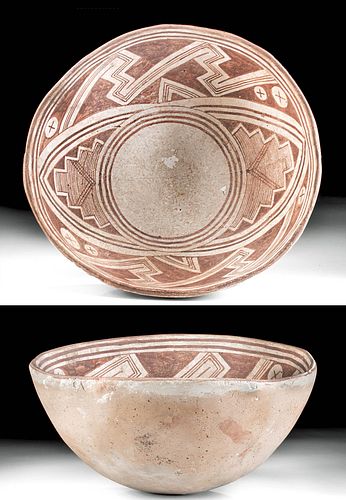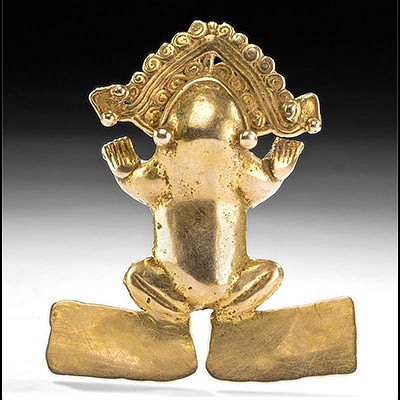Large Native American Mimbres Pottery Bowl
Lot 109c
About Seller
Artemis Fine Arts
686 S Taylor Ave, Ste 106
Louisville, CO 80027
United States
Selling antiquities, ancient and ethnographic art online since 1993, Artemis Gallery specializes in Classical Antiquities (Egyptian, Greek, Roman, Near Eastern), Asian, Pre-Columbian, African / Tribal / Oceanographic art. Our extensive inventory includes pottery, stone, metal, wood, glass and textil...Read more
Estimate:
$1,200 - $1,800
Absentee vs Live bid
Two ways to bid:
- Leave a max absentee bid and the platform will bid on your behalf up to your maximum bid during the live auction.
- Bid live during the auction and your bids will be submitted real-time to the auctioneer.
Bid Increments
| Price | Bid Increment |
|---|---|
| $0 | $25 |
| $300 | $50 |
| $1,000 | $100 |
| $2,000 | $250 |
| $5,000 | $500 |
| $10,000 | $1,000 |
| $20,000 | $2,500 |
| $50,000 | $5,000 |
| $100,000 | $10,000 |
| $200,000 | $20,000 |
About Auction
By Artemis Fine Arts
Aug 13, 2020
Set Reminder
2020-08-13 10:00:00
2020-08-13 10:00:00
America/New_York
Bidsquare
Bidsquare : Fine Antiquities, Ethnographic & Fine Art
https://www.bidsquare.com/auctions/artemis-gallery/fine-antiquities-ethnographic-fine-art-5415
Features classical antiquities, ancient and ethnographic art from cultures encompassing the globe. Egyptian, Greek, Roman, Etruscan, Near Eastern, Asian, Pre-Columbian, Native American, African / Tribal, Oceanic, Spanish Colonial, Russian, Fine Art, so much more! Artemis Fine Arts info@artemisfinearts.com
Features classical antiquities, ancient and ethnographic art from cultures encompassing the globe. Egyptian, Greek, Roman, Etruscan, Near Eastern, Asian, Pre-Columbian, Native American, African / Tribal, Oceanic, Spanish Colonial, Russian, Fine Art, so much more! Artemis Fine Arts info@artemisfinearts.com
- Lot Description
Native American, southwest corner of New Mexico, Mogollon Classic Mimbres, ca. 900 to 1100 CE. A lovely example of a Mimbres black-on-white vessel that was overfired, leading to the black pigment becoming a deep, earthy red color. This vessel was created via the traditional coil-and-scrape method and intricately painted on the interior with concentric circles at the center flanked by fineline pyramidal motifs adorned by horizontal striations superimposed by three V-shaped motifs. To either side are crescent shaped sections decorated with cross-adorned circular motifs and running angular linear motifs. Note the repaired kill hole through the base of this bowl. See more on this below. Size: 12.625" W x 7" H (32.1 cm x 17.8 cm)
Archaeologists believe that the Mimbres peoples would invert a bowl over the face of the deceased and punch a ceremonial "kill hole" through the bottom. It is believed that this allowed the spirit of the bowl - and thus the deceased - to be released from its earthly form. The "kill hole" is a sign of an earlier (ca. 900 to 1100 CE) burial underneath the floor of a house; later (ca. 1100 to 1350 CE), bowls were broken into many pieces, the pieces scattered around the deceased in the grave.
The Mimbres resided in a region that today is in New Mexico’s southwest corner, extending beyond the border with Arizona, and also moving into the Mexican state of Chihuahua. Archaeologists regard Mimbres asa subset of the Mogollon culture. The Mogollon were one of three major cultures - along with the Anasazi, also referred to as the Ancestral Pueblo, and the Hohokam - who lived in the ancient American Southwest.
Provenance: private Orange County, California, USA collection acquired before 2000
All items legal to buy/sell under U.S. Statute covering cultural patrimony Code 2600, CHAPTER 14, and are guaranteed to be as described or your money back.
A Certificate of Authenticity will accompany all winning bids.
We ship worldwide and handle all shipping in-house for your convenience.
#157386Repaired from several pieces, with perhaps 10% to 15% restoration.Condition
- Shipping Info
-
All shipping is handled in-house for your convenience. Your invoice from Artemis Gallery will include shipping calculation instructions. If in doubt, please inquire BEFORE bidding for estimated shipping costs for individual items.
-
- Buyer's Premium



 EUR
EUR CAD
CAD AUD
AUD GBP
GBP MXN
MXN HKD
HKD CNY
CNY MYR
MYR SEK
SEK SGD
SGD CHF
CHF THB
THB

















